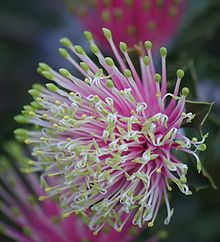| Banksia cuneata | |
|---|---|

| |
| Scientific classification | |
| Kingdom: | Plantae |
| Clade: | Tracheophytes |
| Clade: | Angiosperms |
| Clade: | Eudicots |
| Order: | Proteales |
| Family: | Proteaceae |
| Genus: | Banksia |
| Subgenus: | Banksia subg. Isostylis |
| Species: | B. cuneata
|
| Binomial name | |
| Banksia cuneata | |
Banksia cuneata, commonly known as matchstick banksia or Quairading banksia,[1] is an endangered species of flowering plant in the family Proteaceae. Endemic to southwest Western Australia, it belongs to Banksia subg. Isostylis, a sub-genus of three closely related Banksia species with inflorescences or flower clusters that are dome-shaped heads rather than characteristic Banksia flower spikes. A shrub or small tree up to 5 m (16 ft) high, it has prickly foliage and pink and cream flowers. The common name Matchstick Banksia arises from the blooms in late bud, the individual buds of which resemble matchsticks. The species is pollinated by honeyeaters (Meliphagidae).
Although B. cuneata was first collected before 1880, it was not until 1981 that Australian botanist Alex George formally described and named the species. There are two genetically distinct population groups, but no recognised varieties. This Banksia is classified as endangered, surviving in fragments of remnant bushland in a region which has been 93% cleared for agriculture. As Banksia cuneata is killed by fire and regenerates from seed, it is highly sensitive to bushfire frequency—fires recurring within four years could wipe out populations of plants not yet mature enough to set seed. Banksia cuneata is rarely cultivated, and its prickly foliage limits its utility in the cut flower industry.
- ^ a b "SPRAT profile - Banksia cuneata — Matchstick Banksia, Quairading Banksia". Australian Government Department of Agriculture, Water and the Environment. Retrieved 5 May 2020.
- ^ "Banksia cuneata". Australian Plant Census. Retrieved 18 April 2020.
